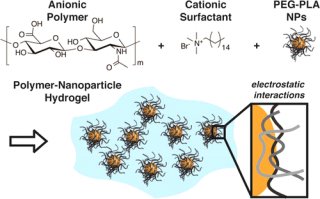
 David H. Koch Institute for Integrative Cancer Research, Department of Chemical Engineering, and Division of Health Science and Technology, Massachusetts Institute of Technology, 77 Massachusetts Avenue, Cambridge, Massachusetts 02139, United States
David H. Koch Institute for Integrative Cancer Research, Department of Chemical Engineering, and Division of Health Science and Technology, Massachusetts Institute of Technology, 77 Massachusetts Avenue, Cambridge, Massachusetts 02139, United States
ACS Macro Lett., 2015, 4 (8), pp 848–852
DOI: 10.1021/acsmacrolett.5b00416
Abstract
Shear-thinning injectable hydrogels exploit dynamic noncovalent cross-links to flow upon applied stress and rapidly self-heal once the stress is relaxed. These materials continue to gather interest as they afford minimally invasive deployment in the body for a variety of biomedical applications. Here, we present rationally engineered polymer–nanoparticle (PNP) interactions based on electrostatic forces for the fabrication of self-assembled hydrogels with shear-thinning and self-healing properties. The selective adsorption of negatively charged biopolymers, including hyaluronic acid (HA) and carboxymethylcellulose (CBMC), to biodegradable nanoparticles comprising poly(ethylene glycol)--poly(lactic acid) (PEG--PLA) is enhanced with a positively charged surfactant, cetyltrimethylammonium bromide (CTAB). We demonstrate that, in this manner, electrostatic interactions can be leveraged to fabricate PNP hydrogels and characterize the viscoelastic properties of the gels imparted by CBMC and HA. This work introduces PNP hydrogels that use common biopolymers without the need for chemical modification, yielding extremely facile preparation and processing, which when coupled with the tunability of their properties are distinguishing features for many important biomedical and industrial applications.
Instrumentation and materials, general synthesis of PEG--PLA block copolymers, general preparation of self-assembled hydrogels, in vivo administration, and supplementary figures. The Supporting Information is available free of charge on the ACS Publications website at DOI: 10.1021/acsmacrolett.5b00416.









